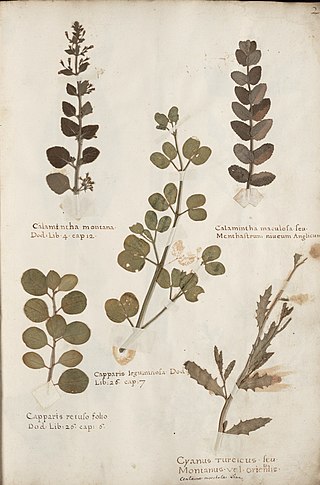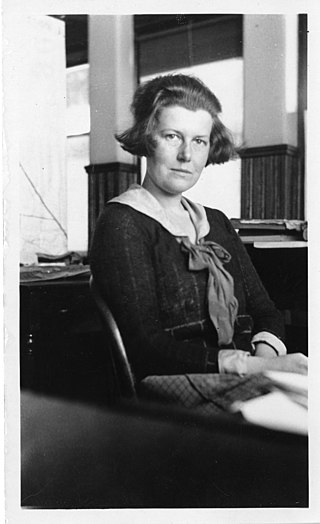
A herbarium is a collection of preserved plant specimens and associated data used for scientific study.

Willis Linn Jepson was an early California botanist, conservationist, and writer.
Coastal strand is a plant community of flowering plants that form along the shore in loose sand just above the high tide line.
The Jepson Manual is a flora of the vascular plants that are either native to or naturalized in California. Botanists often refer to the book simply as Jepson. It is produced by the University and Jepson Herbaria, of the University of California, Berkeley. Its second edition is the basis of the online Jepson eFlora.

Allium acuminatum, also known as the tapertip onion or Hooker's onion, is a species in the genus Allium native to North America.

The National Herbarium of Victoria is one of Australia's earliest herbaria and the oldest scientific institution in Victoria. Its 1.5 million specimens of preserved plants, fungi and algae—collectively known as the State Botanical Collection of Victoria—comprise the largest herbarium collection in Australia and Oceania.
Charles Noyes Forbes (1883–1920) was an American botanist who primarily worked on Hawaii.

Diplacus douglasii is a species of monkeyflower known by the common names brownies and purple mouse ears. It is native to the mountains and foothills of California and Oregon, where it is often found on serpentine soils. D. douglasii was first described in a published flora by George Bentham, an English botanist who was considered "the premier systematic botanist of the nineteenth century,." It was later described by Asa Gray, the father of North American botany.

Ribes canthariforme is a rare species of currant commonly known as the Moreno currant. It is characterized by pink to red flowers, a dense inflorescence, and a lack of nodal spines. A little-known endemic to the mountains of San Diego County, it is usually found growing the shade of massive boulders in the chaparral. Although the rarity and small numbers of this plant is a conservation concern, it is usually found in remote areas and is well hidden enough to be safe from most threats.

Mary Katharine Brandegee was an American botanist known for her comprehensive studies of flora in California.

Roxana Judkins Stinchfield Ferris was an American botanist.

A scientific collection is a collection of items that are preserved, catalogued, and managed for the purpose of scientific study.
Robert Ornduff (1932–2000) was an American botanist. He was Director of the University and Jepson Herbaria, Director of the University of California Botanical Garden, Executive Director of the Miller Institute for Basic Research in Science, and Chair of the (former) Department of Botany and Professor of Integrative Biology at the University of California at Berkeley. Botanist Phyllis M. Faber said of him following his death, "his extensive knowledge and love of the California flora remains unmatched."
Paul Claude Silva was a phycologist, marine biologist, and algal taxonomist considered to be the world's leading expert in the chlorophyte green algal genus Codium. Silva was also an expert in botanical nomenclature and was an editor of the International Code of Botanical Nomenclature's Eighth through Sixteenth International Botanical Congresses.

Fritillaria biflora var. ineziana, the Hillsborough chocolate lily, is a species of fritillary endemic to San Mateo County, California. It grows on serpentinite in cismontane woodland and valley and foothill grassland at elevations that range from 295 to 525 feet It is typically found on serpentine soils, and it is defined as a "broad endemic" where 85-94% of occurrences are expected to occur on ultramafic soils.

Quercus × morehus, Abram's oak in Kellogg's original description, is a named hybrid between the red oaks Quercus kelloggii and Quercus wislizeni. Originally published as the unique species Quercus morehus by Kellogg, rather than as the hybrid it is called today, this tree is found in the US states of California and possibly southern Oregon, usually where the territories of the purported parents overlap.
Nathaniel Lyon Gardner, was an American phycologist and mycologist who taught at the University of California, Berkeley, where he was the curator of the University Herbarium. He is known for his work on seaweeds of the Pacific Coast, as well as on freshwater algae and fungi, and among his publications is the important reference work Algae of Northwestern America.
William Albert Setchell was an American botanist and marine phycologist who taught at the University of California, Berkeley, where he headed the Botany Department. Among his publications are the Phycotheca Boreali-Americana, a multi-volume specimen collection of dried algae, and the Algae of Northwestern America, a reference work.
Milo Samuel Baker was an American botanist, specializing in plants of the northern coastal region of California, as well as the genus Viola.
Herbert LouisMason (1896–1994) was an American botany professor, plant collector, and herbarium director.












